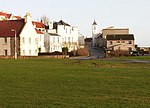Dysart, Fife

Dysart ( ; Scottish Gaelic: Dìseart) is a town and former royal burgh located on the south-east coast between Kirkcaldy and West Wemyss in Fife, Scotland. Dysart was once part of a wider estate owned by the St Clair or Sinclair family. They were responsible for gaining burgh of barony status for the town towards the end of the 15th century. The first record of the town was made in the early 13th century, its initial role being to settle civil matters between the church and landowners. During the middle of the 15th century, trade with the Low Countries began for salt and coal exportation. In the 16th and 17th centuries, trade expanded to the Baltic Countries. Dysart acquired two nicknames: "Salt Burgh" and "Little Holland" as a result. Following the sudden decline of the town's harbour caused by the closure of the Lady Blanche Pit, the town was amalgamated into the royal burgh of Kirkcaldy under an act of parliament in 1930. Urban clearance during the 1950s and 1960s saw large parts of the historic town demolished for new housing. Demand from the town's residents meant that part of the historic town — most notably the 16th-century and the 18th-century houses of Pan Ha' opposite the harbour — were salvaged and preserved for future generations.
Excerpt from the Wikipedia article Dysart, Fife (License: CC BY-SA 3.0, Authors, Images).Dysart, Fife
Wemyss Road,
Geographical coordinates (GPS) Address Nearby Places Show on map
Geographical coordinates (GPS)
| Latitude | Longitude |
|---|---|
| N 56.13 ° | E -3.11 ° |
Address
Frances Pit headframe
Wemyss Road
KY1 2XZ , Dysart
Scotland, United Kingdom
Open on Google Maps










